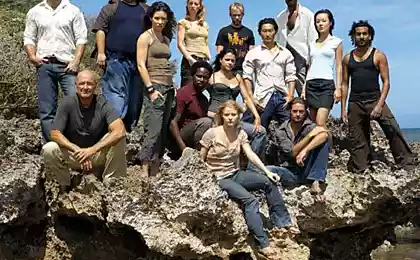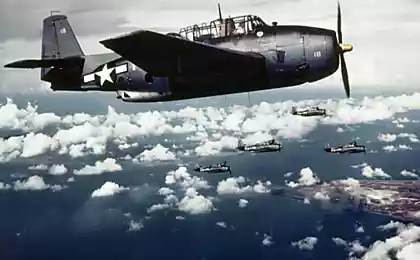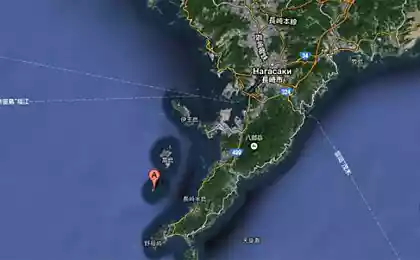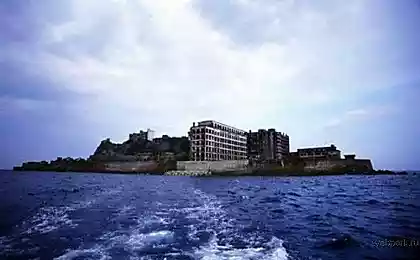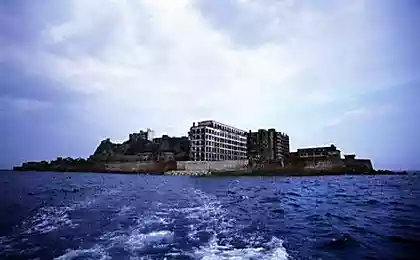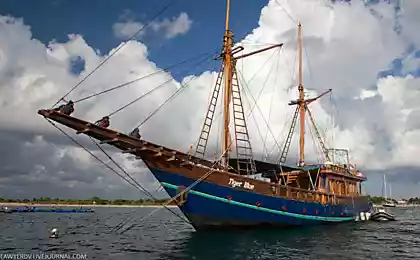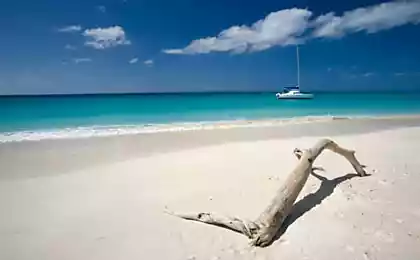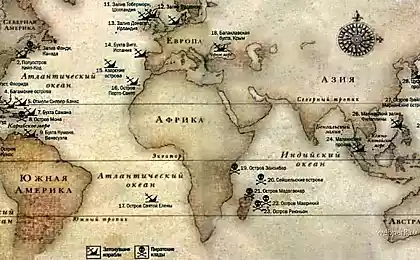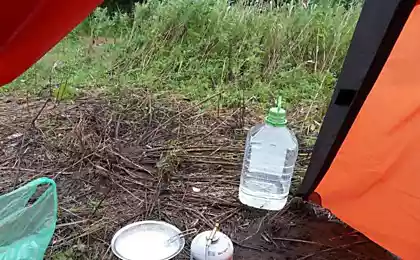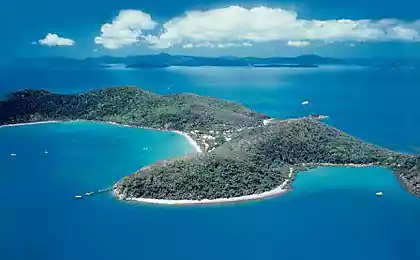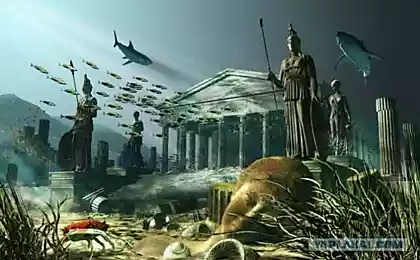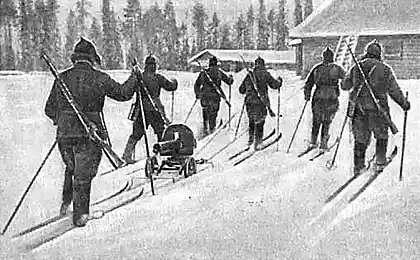1277
The most terrible and mysterious island
The isolation of the island - a guarantee of having his terrible secret. Everything - from shipwrecks and cannibalism before the nuclear tests. Some islands except nightmare called simply impossible.
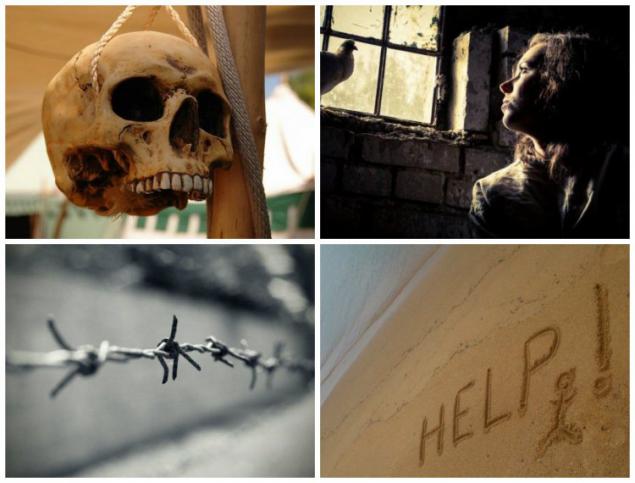
10. Island Tiburon. Gold and cannibalism
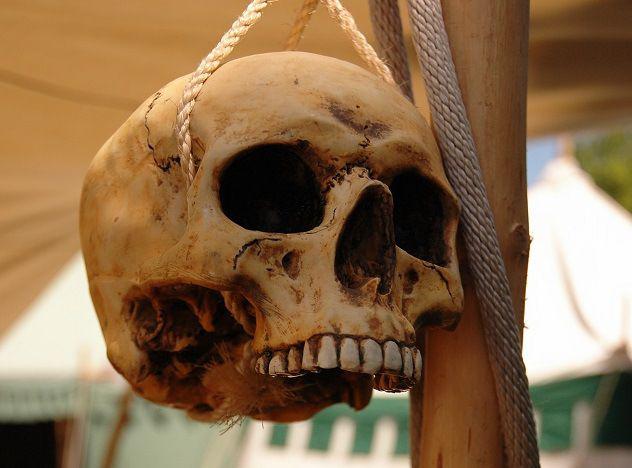
Tiburon Island is the largest island in Mexico. It is very hot, the soil is not suitable for growing economic crops underfoot bunch of poisonous animals, and inhabits his ethnic group lives Seri, which has long been considered cannibals. On it is also rumored to be hiding untold wealth of ancient and beneath the surface of many precious metals.
Arizona pioneer and explorer of the island, Tom Grindell, made his first trip to the island in 1903. Then he just stuck to the beach to look around and decide whether or not to organize a full-scale operations for the exploration of the island. Having made the decision, he returned to Arizona to hire a helper. He was joined by three. They went to the island June 10, 1905, promising to return by the end of July. But they have not returned.
Grindella brother, Edward, there followed in September to find out what happened. When he arrived in the city from which went to the researchers, it got the attention of hunters in the summer on the island was killed by a group of Americans. All that remains of them is hand tied to the tall trees. Seri people tied their prisoners, depriving them of the forces gradually eating in parts, and watching them die.
Edward Grindell decided that the hand belonged to a member of another expedition. Fiza Edward and his little group found the remains of a large number of arms belonging to other would-be researchers. Edward and his companions found traces of his brother - a dead mule, rifle and a book by Tom, but no body. Remains of Tom Grindella were found two years later. Of them remained a pile of bones, and identified them by the letters which lay nearby.
Half a century later went to the island of friendly expedition to examine these supposedly ferocious people. Researchers have found a good and courteous tribe, which sought to share their lifestyle with visitor. When the expedition tried to find out if the rumors are true about cannibalism, the islanders have explained that the Mexican government has set limits for their cannibalistic activities, threatening them with death in case of repetition of the mysterious disappearance of visitors to the island.
9. Thilafushi. Garbage island in paradise
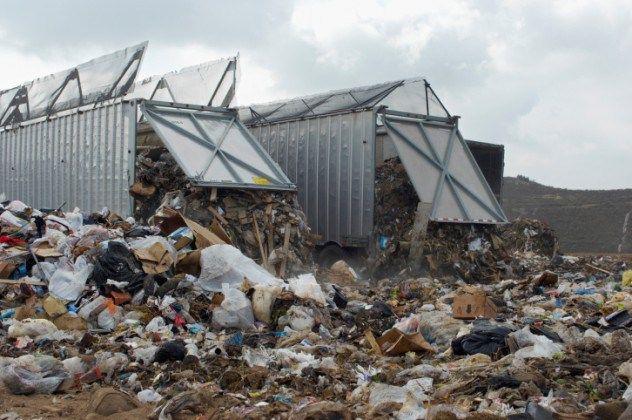
Maldives - a tropical paradise with white beaches and clear water. This is a picture that shows an island nation tour.
Thilafushi - an artificial island that was created for waste disposal. Good intention, because every week more than 10,000 tourists visit the island, and this output gives a lot of garbage. The so-called Garbage Island is home to about 150 people whose job is to parse the debris, for further processing. Now the island every day brought more than 330 tons of garbage, so that the sorting of waste already forgotten.
Unfortunately, this means the amount of garbage that most of it is burned. Burn everything: electronics, batteries and plastic, all this leads to pollution of air and ocean.
8. fraternal North Island. Shipwreck General Slocum

Fraternal North Island was the site of one of the biggest human tragedies in New York. June 15, 1904 Lutheran Evangelical Church. Mark holds an annual picnic on Eaton's Neck. More than 1000 members boarded the steamship General Slocum to tour of the Lower East Side to the venue picnic. On board were a large number of women and children.
As long as the boat moves along the East River, it caught fire and it is only half an hour after leaving port. Burning ship was sent to the North sister island, which is considered the captain, was the best option. That morning 1,358 passengers boarded the ship and 1,021 of them died. To be clear, the only list a large number of concurrent victims in the history of the United States - the attack on the World Trade Center.
After the collapse of the body washed up on the shore of the North sister island, where they were laid out along the pier and coastline. It was a terrible picture, and the family wandered among hundreds of charred drowned bodies in search of relatives. Later Captain condemned because nobody on the ship did not comply with safety regulations. Fire hoses rotted, rescue boats were downloadable format at the port, even life jackets were useless - they are pulled to the bottom of accidents when they jump from the burning ship.
7. Gruinard Island. Testing anthrax

In 1942, the British government decided that the biggest world power, which they themselves believed to be all kinds of deadly weapons and began experimenting with anthrax. They should have somewhere to conduct experiments, so they went north to the island a few hundred meters from the coast of Scotland.
In the late 1800s Gruinard Island was home to a handful of people and a nice small rural town. Since almost all the inhabitants left the island in 1930, it was decided to use the small island as a laboratory to study the effects of anthrax. It was decided to bring to the island a small herd of about 60 sheep, and then drop the bomb anthrax. Not surprisingly, the sheep died.
Several bombs were dropped on the island in 1942 and 1943, while no one objected. These problems arose after. In 1945, the owner of the island of Gruinard wanted their land back, but the government considered the island uninhabitable animals or humans. They are, however, ruled that the owner or his heirs can redeem the island government, once it becomes clear for 500 £.
More problems appeared when infected with anthrax carcasses beginning nailed to the coast of mainland Scotland, infecting other animals. As you know, the government has never spoken in the neighboring continent than they are actually engaged on the island. Immediately the island was cleared very questionable way - spray water connection and formaldehyde to kill all disputes. Unfortunately, as soon as he was again safe for habitation, received another suggestion - use the island as a place for the storage of nuclear waste.
6. San Servolo. Psychiatric Hospital

The island of San Servolo is located off the coast of Italy. Today it is a museum it is quite frightening past. The museum was formerly a hospital and is intended for wounded soldiers. In the first half of the 19th century, however, it has become a «morocomio» or institution for the insane.
Interestingly, the institution was religious, and its control over the management of the ancient religious order of San Giovanni di Dio, famous for its medical experts. Key treatments insane patients were absolute isolation and repression. Order adhered to the practice, which they called "moral treatment". This practice involves methods that, by today's standards, with brutal border.
The museum demostriruet chain, straitjackets and handcuffs that were used on patients. Here ECT could be used on a par with the open dialogue between patient and physician. Perhaps this place scares more than other similar institutions, because violence is mingled with a very deep conversation and massages.
5. Island Brown. The tragedy of the Civil War
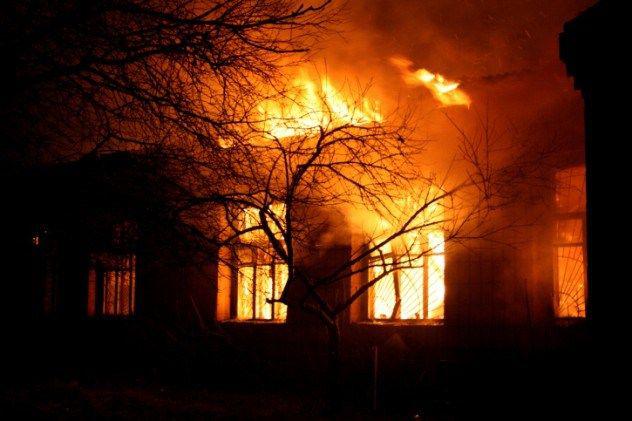
Early laboratory ammunition were dangerous places, and the tragic events in the island Brown direct proof. In 1863, Brown's Island was built complex of wooden buildings. They had to stay in the Federal Laboratory of ammunition, which was considered too dangerous to be placed in populated areas of the mainland Virginia.
March 13, 1863 still inevitable happened. Minor Irish immigrant named Mary Ryan was at the center of the explosion. Ryan made a simple but fatal mistake, she knocked on the wooden board books, creating friction.
The explosion destroyed most of the building, which is about 80-100 young women. As a result, 44 died, but few have died instantly. Most blind and suffered serious burns. Mary Ryan herself was in serious condition for several days before died of wounds on March 16.
The ultimate cause of the tragedy was the combination of books, wooden planks, and the presence of gunpowder in the air. Work at the plant resumed the end of March after the new staff recruited.
4. Solovki. Religion and Gulag
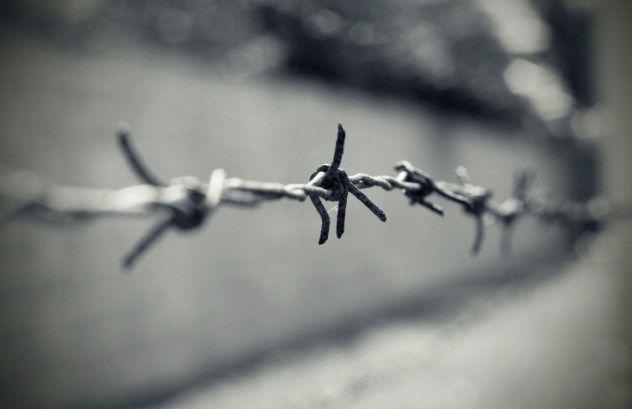
During the 15 th and 16 th centuries, the monastery and the village on the Solovetsky Islands was filled with monks who chronicled their lives, produced salt and chopped wood.
In the 17-18 centuries the island was gradually transformed into a prison colony, which became the Soviet gulag. Were the first people who came here for treason, blasphemy, theft and vagrancy. The prisoners were kept in buildings where once a monastery, and the monks who still live on the island, the work assigned to prison warden. More than 400 prisoners sent to the island of Ivan the Terrible, and in 1798 began to build more suitable for the prison building.
Later, the prison became a concentration camp, a place of residence for those who were considered "problem" during the civil war in Russia. In 1923 the island became known as the Special Purpose Camp. In 1937 there were about 2,000 people were killed.
Surviving prisoners have described the terrible conditions of detention. The guards used sea hooks to pull the dead, frozen body from the cold buildings, while the prisoners were struggling to leave the body as food.
3. Eniwetok Atoll. Nuclear deterrence

Coral Eniwetok Atoll - a breathtaking ring of tropical islands in the Pacific Ocean. Now there are fewer islands than it was before World War II, however, because all the local people were resettled, the US government has been able to turn a number of islands of paradise in the nuclear test site.
After the first nuclear test at Bikini Atoll in 1946, all the inhabitants were moved to Eniwetok Atoll Udzheleng. And in 1948, began operation Sandstone, and over the next decade was blown up in the overall ease of 43 nuclear bombs. One of them, code-named Ivy Mike, was 500 times greater than the bomb dropped on Hiroshima. It completely destroyed the island Eludzheleb, leaving absolutely nothing on the site of the island, except kilometer crater. The same explosion created two new plutonium isotopes and led to the discovery of two new heavy elements. And for nature meant massive pollution.
Residents were returned back to the island in the early 1970s, but only in 1979 finally realized cleaning. All "dirty" ground collected and placed under concrete 8 meter dome. Since 2008 in the dome appear more and more cracks.
2. Nazin Island. Russian settlement
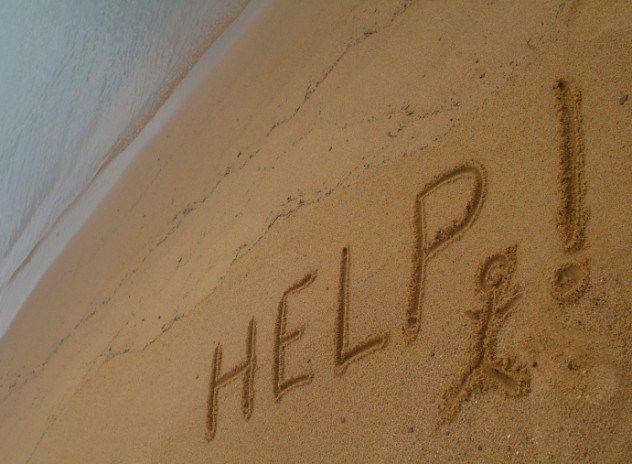
Nazin deserted island, almost uninhabitable river island 2,400 kilometers north-east of Moscow. It is on this island in 1933 were deported 6,200 people. These 6,200 people were sent to the place which later became known as the Cannibal Island.
They did not provide any utensils or tools, nor food. Their only "food" - soaked flour piled up along the shore. Dirty river water - was the only source of water, and those who saw it, fell ill with dysentery. Those who tried to escape from the island, was shot dead by security guards. A handful of survivors on the island, remember corpses bombers choking the earth, human flesh cut from their bodies and saved to eat later.
Originally Nazin planned as a short stop on the way to the final camp, but it lasted a month, and cannibalism began about 10 days.
1. Forty Island. Leprosarium Korea
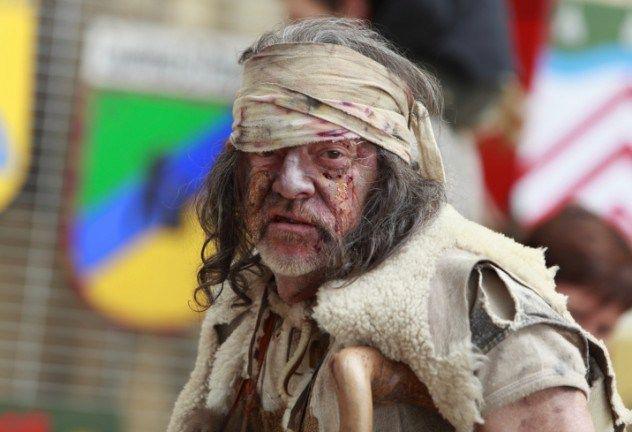
Park Ji-Sung, worked on his farm in South Korea, where the authorities took him and sent out of the country on the island of Forty. His first task when he was there - was cleaning the operating room. She was covered in blood, and in the center stood a table equipped with chains. Put a stigma on it - a leper. He was one of many who were exiled to the breathtaking beautiful island on the southern coast of Korea.
The beautiful beaches of the island hide a dark past. Forty island leper colony was more than 100 years, yet belonged to the Japanese. But nothing has changed when control passed to Korea. Exiled there were patients and criminals, and their life was from a series of brutal labor and repression. Some were left untreated because doctors wanted to study the natural history of the disease. Others were sterilized, and those who are allowed to marry and have children, have been forced to send them to the mainland before they reach school age. Those pregnancies that have not been approved, ended in forced abortion.
The island was controlled by guards. As recorded in his chronicle, one was known for his kindness, but he was an exception to the rule. Other residents forced to bow his statue every morning before they could eat. In 1942, he was stabbed to death and his murderer was executed.
Now it connects the island to the mainland by a bridge, but those who live there still a stigma imposed lepers. Even though they are cured of all diseases, many were mutilated. Today's residents were sent to the island by young and very young woman on the island was about 80 at the time of construction and opening of the bridge in 2007. Paranoia and disgust that they see on the faces of the inhabitants of the continent, just terrible for them, as the treatment that they once held on the island.

10. Island Tiburon. Gold and cannibalism

Tiburon Island is the largest island in Mexico. It is very hot, the soil is not suitable for growing economic crops underfoot bunch of poisonous animals, and inhabits his ethnic group lives Seri, which has long been considered cannibals. On it is also rumored to be hiding untold wealth of ancient and beneath the surface of many precious metals.
Arizona pioneer and explorer of the island, Tom Grindell, made his first trip to the island in 1903. Then he just stuck to the beach to look around and decide whether or not to organize a full-scale operations for the exploration of the island. Having made the decision, he returned to Arizona to hire a helper. He was joined by three. They went to the island June 10, 1905, promising to return by the end of July. But they have not returned.
Grindella brother, Edward, there followed in September to find out what happened. When he arrived in the city from which went to the researchers, it got the attention of hunters in the summer on the island was killed by a group of Americans. All that remains of them is hand tied to the tall trees. Seri people tied their prisoners, depriving them of the forces gradually eating in parts, and watching them die.
Edward Grindell decided that the hand belonged to a member of another expedition. Fiza Edward and his little group found the remains of a large number of arms belonging to other would-be researchers. Edward and his companions found traces of his brother - a dead mule, rifle and a book by Tom, but no body. Remains of Tom Grindella were found two years later. Of them remained a pile of bones, and identified them by the letters which lay nearby.
Half a century later went to the island of friendly expedition to examine these supposedly ferocious people. Researchers have found a good and courteous tribe, which sought to share their lifestyle with visitor. When the expedition tried to find out if the rumors are true about cannibalism, the islanders have explained that the Mexican government has set limits for their cannibalistic activities, threatening them with death in case of repetition of the mysterious disappearance of visitors to the island.
9. Thilafushi. Garbage island in paradise

Maldives - a tropical paradise with white beaches and clear water. This is a picture that shows an island nation tour.
Thilafushi - an artificial island that was created for waste disposal. Good intention, because every week more than 10,000 tourists visit the island, and this output gives a lot of garbage. The so-called Garbage Island is home to about 150 people whose job is to parse the debris, for further processing. Now the island every day brought more than 330 tons of garbage, so that the sorting of waste already forgotten.
Unfortunately, this means the amount of garbage that most of it is burned. Burn everything: electronics, batteries and plastic, all this leads to pollution of air and ocean.
8. fraternal North Island. Shipwreck General Slocum

Fraternal North Island was the site of one of the biggest human tragedies in New York. June 15, 1904 Lutheran Evangelical Church. Mark holds an annual picnic on Eaton's Neck. More than 1000 members boarded the steamship General Slocum to tour of the Lower East Side to the venue picnic. On board were a large number of women and children.
As long as the boat moves along the East River, it caught fire and it is only half an hour after leaving port. Burning ship was sent to the North sister island, which is considered the captain, was the best option. That morning 1,358 passengers boarded the ship and 1,021 of them died. To be clear, the only list a large number of concurrent victims in the history of the United States - the attack on the World Trade Center.
After the collapse of the body washed up on the shore of the North sister island, where they were laid out along the pier and coastline. It was a terrible picture, and the family wandered among hundreds of charred drowned bodies in search of relatives. Later Captain condemned because nobody on the ship did not comply with safety regulations. Fire hoses rotted, rescue boats were downloadable format at the port, even life jackets were useless - they are pulled to the bottom of accidents when they jump from the burning ship.
7. Gruinard Island. Testing anthrax

In 1942, the British government decided that the biggest world power, which they themselves believed to be all kinds of deadly weapons and began experimenting with anthrax. They should have somewhere to conduct experiments, so they went north to the island a few hundred meters from the coast of Scotland.
In the late 1800s Gruinard Island was home to a handful of people and a nice small rural town. Since almost all the inhabitants left the island in 1930, it was decided to use the small island as a laboratory to study the effects of anthrax. It was decided to bring to the island a small herd of about 60 sheep, and then drop the bomb anthrax. Not surprisingly, the sheep died.
Several bombs were dropped on the island in 1942 and 1943, while no one objected. These problems arose after. In 1945, the owner of the island of Gruinard wanted their land back, but the government considered the island uninhabitable animals or humans. They are, however, ruled that the owner or his heirs can redeem the island government, once it becomes clear for 500 £.
More problems appeared when infected with anthrax carcasses beginning nailed to the coast of mainland Scotland, infecting other animals. As you know, the government has never spoken in the neighboring continent than they are actually engaged on the island. Immediately the island was cleared very questionable way - spray water connection and formaldehyde to kill all disputes. Unfortunately, as soon as he was again safe for habitation, received another suggestion - use the island as a place for the storage of nuclear waste.
6. San Servolo. Psychiatric Hospital

The island of San Servolo is located off the coast of Italy. Today it is a museum it is quite frightening past. The museum was formerly a hospital and is intended for wounded soldiers. In the first half of the 19th century, however, it has become a «morocomio» or institution for the insane.
Interestingly, the institution was religious, and its control over the management of the ancient religious order of San Giovanni di Dio, famous for its medical experts. Key treatments insane patients were absolute isolation and repression. Order adhered to the practice, which they called "moral treatment". This practice involves methods that, by today's standards, with brutal border.
The museum demostriruet chain, straitjackets and handcuffs that were used on patients. Here ECT could be used on a par with the open dialogue between patient and physician. Perhaps this place scares more than other similar institutions, because violence is mingled with a very deep conversation and massages.
5. Island Brown. The tragedy of the Civil War

Early laboratory ammunition were dangerous places, and the tragic events in the island Brown direct proof. In 1863, Brown's Island was built complex of wooden buildings. They had to stay in the Federal Laboratory of ammunition, which was considered too dangerous to be placed in populated areas of the mainland Virginia.
March 13, 1863 still inevitable happened. Minor Irish immigrant named Mary Ryan was at the center of the explosion. Ryan made a simple but fatal mistake, she knocked on the wooden board books, creating friction.
The explosion destroyed most of the building, which is about 80-100 young women. As a result, 44 died, but few have died instantly. Most blind and suffered serious burns. Mary Ryan herself was in serious condition for several days before died of wounds on March 16.
The ultimate cause of the tragedy was the combination of books, wooden planks, and the presence of gunpowder in the air. Work at the plant resumed the end of March after the new staff recruited.
4. Solovki. Religion and Gulag

During the 15 th and 16 th centuries, the monastery and the village on the Solovetsky Islands was filled with monks who chronicled their lives, produced salt and chopped wood.
In the 17-18 centuries the island was gradually transformed into a prison colony, which became the Soviet gulag. Were the first people who came here for treason, blasphemy, theft and vagrancy. The prisoners were kept in buildings where once a monastery, and the monks who still live on the island, the work assigned to prison warden. More than 400 prisoners sent to the island of Ivan the Terrible, and in 1798 began to build more suitable for the prison building.
Later, the prison became a concentration camp, a place of residence for those who were considered "problem" during the civil war in Russia. In 1923 the island became known as the Special Purpose Camp. In 1937 there were about 2,000 people were killed.
Surviving prisoners have described the terrible conditions of detention. The guards used sea hooks to pull the dead, frozen body from the cold buildings, while the prisoners were struggling to leave the body as food.
3. Eniwetok Atoll. Nuclear deterrence

Coral Eniwetok Atoll - a breathtaking ring of tropical islands in the Pacific Ocean. Now there are fewer islands than it was before World War II, however, because all the local people were resettled, the US government has been able to turn a number of islands of paradise in the nuclear test site.
After the first nuclear test at Bikini Atoll in 1946, all the inhabitants were moved to Eniwetok Atoll Udzheleng. And in 1948, began operation Sandstone, and over the next decade was blown up in the overall ease of 43 nuclear bombs. One of them, code-named Ivy Mike, was 500 times greater than the bomb dropped on Hiroshima. It completely destroyed the island Eludzheleb, leaving absolutely nothing on the site of the island, except kilometer crater. The same explosion created two new plutonium isotopes and led to the discovery of two new heavy elements. And for nature meant massive pollution.
Residents were returned back to the island in the early 1970s, but only in 1979 finally realized cleaning. All "dirty" ground collected and placed under concrete 8 meter dome. Since 2008 in the dome appear more and more cracks.
2. Nazin Island. Russian settlement

Nazin deserted island, almost uninhabitable river island 2,400 kilometers north-east of Moscow. It is on this island in 1933 were deported 6,200 people. These 6,200 people were sent to the place which later became known as the Cannibal Island.
They did not provide any utensils or tools, nor food. Their only "food" - soaked flour piled up along the shore. Dirty river water - was the only source of water, and those who saw it, fell ill with dysentery. Those who tried to escape from the island, was shot dead by security guards. A handful of survivors on the island, remember corpses bombers choking the earth, human flesh cut from their bodies and saved to eat later.
Originally Nazin planned as a short stop on the way to the final camp, but it lasted a month, and cannibalism began about 10 days.
1. Forty Island. Leprosarium Korea

Park Ji-Sung, worked on his farm in South Korea, where the authorities took him and sent out of the country on the island of Forty. His first task when he was there - was cleaning the operating room. She was covered in blood, and in the center stood a table equipped with chains. Put a stigma on it - a leper. He was one of many who were exiled to the breathtaking beautiful island on the southern coast of Korea.
The beautiful beaches of the island hide a dark past. Forty island leper colony was more than 100 years, yet belonged to the Japanese. But nothing has changed when control passed to Korea. Exiled there were patients and criminals, and their life was from a series of brutal labor and repression. Some were left untreated because doctors wanted to study the natural history of the disease. Others were sterilized, and those who are allowed to marry and have children, have been forced to send them to the mainland before they reach school age. Those pregnancies that have not been approved, ended in forced abortion.
The island was controlled by guards. As recorded in his chronicle, one was known for his kindness, but he was an exception to the rule. Other residents forced to bow his statue every morning before they could eat. In 1942, he was stabbed to death and his murderer was executed.
Now it connects the island to the mainland by a bridge, but those who live there still a stigma imposed lepers. Even though they are cured of all diseases, many were mutilated. Today's residents were sent to the island by young and very young woman on the island was about 80 at the time of construction and opening of the bridge in 2007. Paranoia and disgust that they see on the faces of the inhabitants of the continent, just terrible for them, as the treatment that they once held on the island.
